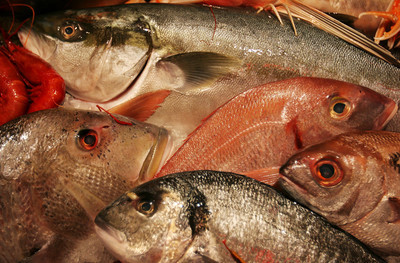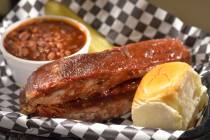Barely Out of the Water
"The fish that's on your plate today
Spent last night in Chesapeake Bay."
-- Menu hyperbole, circa 1970
Seafood in the desert? Isn't there something a little ... well ... oxymoronic about that?
"I love that question," said Rick Moonen, executive chef/owner of rm seafood at Mandalay Bay. "And it does come up often."
But Moonen and other local chefs say that thanks to modern transportation and technology, the seafood served in their Las Vegas restaurants is as fresh as that '70s East Coast spot purported its to be.
"Halibut's off the boat one to two days from the time we get it," Moonen said.
"I would say that ... our fish has generally been out of the water for two or three days," said Stephen Hopcraft, executive chef of Seablue at MGM Grand.
"They get it out of the water and it's flown out the same day," said Jason Talbott, executive chef at McCormick & Schmick's in the Hughes Center.
"I couldn't imagine it being more than two or three days out of the water, if that," said David Walzog, executive chef at SW Steakhouse at Wynn Las Vegas.
Even the more far-flung supplies are delivered quickly, the chefs said. Moonen said his hamachi is cleaned and flown fresh from Japan in less than four days, "which is pretty amazing."
And Paul Bartolotta, executive chef of Bartolotta Ristorante di Mare at Wynn Las Vegas, who every week imports 11/2 tons of seafood primarily from the major fish markets of Italy, said his supply arrives three to four days after it's removed from Mediterranean waters.
All of which sounds great, but is it more menu hyperbole? How is it possible?
Because of a lot of factors, the chefs said. But beyond the global-overnight swiftness of air shipping, they differ on many of the details.
Hopcraft said Seablue -- a Michael Mina restaurant -- relies on purveyors who have boats that go out every morning. Two days in advance, if he predicts he'll need 35 pounds of scallops, he contacts one of his East Coast purveyors and lets them know.
"Basically, their boat goes out, and in addition to all the other orders that have been called in to them, they fish for that product," he said. "It's overnighted to me."
Walzog said his purveyors -- whose locations include San Francisco, Los Angeles, Hawaii and on Cape Cod -- use a different method.
"They're at the auctions and markets daily, selecting fish that are within the specs that we ask for," he said. "They buy them and we get them in the morning. That's the fastest possible way."
One thing they agree on: It's important to know and trust your suppliers.
"I know the names of all of my connections," Moonen said. "I'm on a first-name basis with all of them."
"We just deal with one purveyor, so we know exactly where we're getting it from and exactly who they are," Talbott said.
Advances in technology also have helped, and not just in the gel-packs that often are used in place of ice to keep the fish from getting waterlogged. Bartolotta said he has his supplier implant a thermal chip in a fish in each shipment, tying a ribbon around the tail to identify it. When the shipment arrives, Bartolotta removes the chip, inserts it into his computer and charts the temperature at which the fish was held -- every 15 minutes -- between Italy and the United States.
"We put an enormous amount of effort into this," he said.
And, Bartolotta said, "it's an enormous risk." He estimated that there are 45 to 55 species of seafood in his restaurant on any given day. If seafood is anything, it's perishable. While Bartolotta has live tanks for langoustines, several types of lobsters and several types of crab, most of his inventory won't keep.
Said Talbott, who generally has 28 to 30 different seafoods on a given day: "Our plan is to run out of fish every day."
Which can, of course, be a problem if it happens too soon. Forecasting supply, Hopcraft said, is "kind of a science. You look at occupancy, room rates -- so you know if the people who are in the hotel are people who would be interested in a restaurant like Seablue. You look at the conventions in town, all up and down the Strip. And use the prior year. Take all those factors and kind of put it into the hopper.
"The other part that's kind of up in the air is you could have 75 reservations come in, and 25 of those people all want ahi tuna. How do you know?
"It's Vegas. There's always a little bit of a gamble to every decision you make."
But not, it seems, when that decision is to eat seafood in the desert.
"I'm checking the seafood, smelling it and checking it very closely to make sure it meets our standards," Talbott said. "If I have any question in my mind, it gets sent back."
"There's an expression that fish travels more after it's dead than when it's alive," Bartolotta said. "And it's very true."
And sometimes, it travels to the desert.
Contact reporter Heidi Knapp Rinella at hrinella@reviewjournal.com or 702-383-0474.
Bartolotta Ristorante di Mare Video FRESH FISH TIPS Want to be sure the fish you're buying is fresh? Here are some tips from Jason Talbott, executive chef at McCormick & Schmick's: • The skin should be shiny. • The flesh should feel firm, with no damage. • There should be a fresh ocean smell, or no odor at all. • Colors should be bright and vibrant. • The eyes should be clear and not cloudy.























